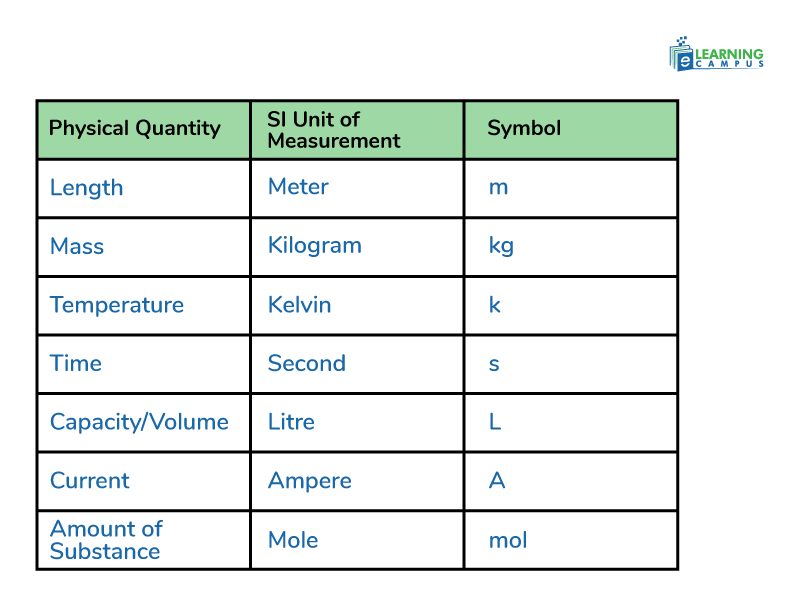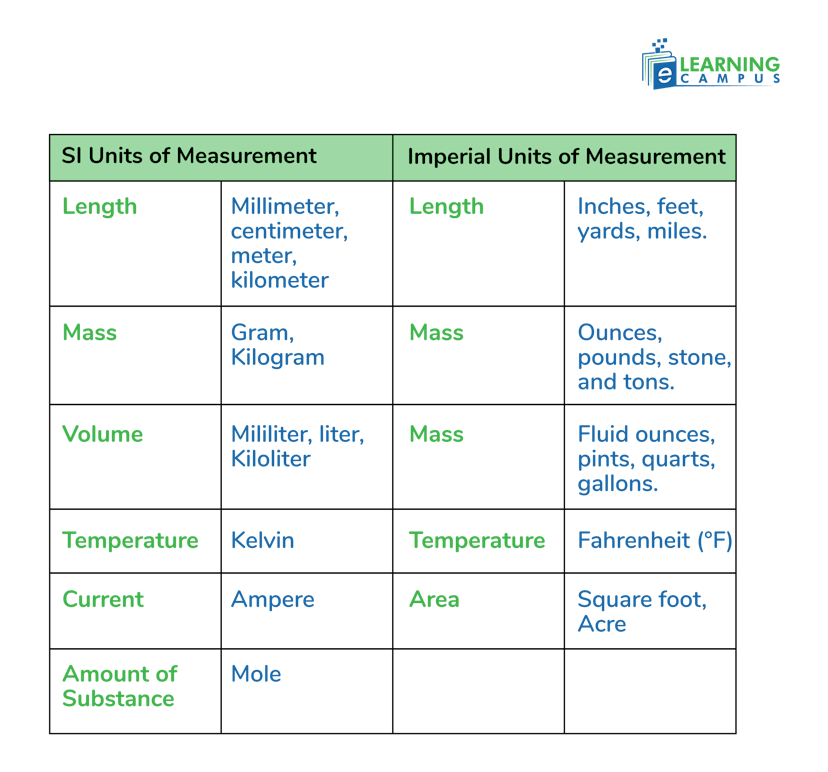Unit of Measurement

A unit of measurement is a quantity that is used to measure physical quantities such as area, volume, length, temperature, mass, etc. A unit of measure is a standardized quantity of physical property used as a factor to express the quantity of that property.
What are Units of Measurement
We deal with different types of physical quantities in our daily lives. These physical quantities are measured with specific and agreed-upon units called units of measurement. So, a standard quantity that is used to measure any kind of physical quantity is called a measuring unit.
Measurement and Measurement System
Numerous physical quantities exist in the world. It is impossible to measure all the quantities with the same unit. Therefore, the idea of measurement and measurement systems has evolved since earlier times. Measurement is the process of assigning a numerical value to a physical quantity, and the procedures and instructions used to make that measurement are called a measurement system.
In the modern era, there are several kinds of measuring systems. We will look at the different types of systems of measurement.
Different Systems of Units of Measurement
In ancient times, people didn’t possess proper tools for measurement. They used informal methods such as parts of the body, hands, feet, and arms to measure the quantities. It led to imperfection and inaccurate measurement.
With the advancement in knowledge and inventions, better units of measurement system was put forward.
Imperial Unit of Measurement
The imperial unit of measurement, also known as the British imperial system, is the standard system of weight and measurement that has been used in Great Britain until the introduction of the metric system.
The imperial unit of measurement chart is given below.

Metric Unit of Measurement
The metric system employs a base set of units and prefixes to measure various quantities. In mathematics, metric units of measurement serve as standard units to quantify area, weight, height, length, and capacity (volume).
Since it is based on the decimal system, it utilizes numbers in powers of ten. In this system, each unit has a size that is universally accepted. The basic units of the metric measurement system are the meter (m) for length, gram (g) for mass, and liter (L) for capacity.
The SI units represent a contemporary version of metric units that are widely recognized.
SI Units of Measurement
SI stands for System International. The International System of Units (SI) is a globally recognized system of measurement based on seven fundamental base units. These base units are known as base units. All other units of measurement are derived from these seven fundamental units. The SI unit of measurement chart is given below.
SI Units Chart
The SI units chart of the seven basic units abbreviation of units is given below.

Let’s discuss the SI units of measurement of some of the physical quantities.
SI Unit for Pressure
The SI unit for pressure is the pascal (Pa), which is equivalent to one newton (force) per square meter (N/m²). One pascal is the pressure exerted by a force of one newton acting on an area of one square meter.
SI Unit of Force
The SI unit of force is the newton, represented by (N). It's defined as the force needed to accelerate a mass of one kilogram at a rate of one meter per second squared (1 m/s²).
SI Unit for Density
Density is the mass per unit volume. Mass is measured in kg and volume is measured in cubic centimeter. So, the The SI unit for density is kilograms per cubic meter (kg/m³).
SI Unit of Distance
The SI unit of distance is the meter (m). It is defined as the length of the path traveled by light in a vacuum during a specific time interval.
SI Unit of Measurement for Volume
The SI unit of measurement for volume is the cubic meter (m³). It represents the volume occupied by a cube with sides of 1 meter each.
SI Unit of Measurement for Energy
The SI unit of measurement for energy is the joule (J). It is defined as the energy transferred when a force of one newton displaces an object by one meter in the direction of the force.
SI Unit of Mass
The SI unit for mass is the kilogram (kg).
Units of Measurement Chart
We use two types of units of measurement in our daily lives. The first one is the base unit, and the second is the derived unit. Below, we provide the base and derived units of measurement chart. Before going to cthe hart, let us know the difference between base units and derived units.
- Base units are fundamental units of measurement that are independent and cannot be derived from other units. There are seven base units in the International System. Such as meter, kg, second, etc.
- Derived Units are formed by combining base units through mathematical relationships or formulas. For example, the square meter (m²) is unit of area that is derived from unit of length (meter).

Measurement Abbreviations
There are various measurement units. The name of the units depends on the quantity measured. Measurement abbreviations are shortened versions of units of measurement. These abbreviations are often derived from the first letter or letters of the names of units.
The abbreviation of unit of measurement are used to save space and time in technical or scientific writings.
Let’s look at some examples of abbreviation for units of measurement.
Weight Abbreviation
The weight abbreviation commonly used is ‘wt’. However, the other units used for measurement of weight include;
- lbs for pounds.
- Oz for ounces.
- Kg for kilograms.
- G for grams.
- mg for milligrams.
- T for tons.
Yard Abbreviation
A yard is a unit of length used in the imperial system. The yard abbreviation is ‘yd’. For instance, 5yd means five yards.
volume abbreviation
The globally used volume abbreviation is ‘vol’. For multiple volumes, ‘vols’ will be used.
Chart of Units of Measurement Abbreviation
Each unit in the international system is represented by a specific abbreviation. The following chart of units of measurement abbreviations shows different abbreviations.

Units of Measurement List
The imperial unit of measurement and the SI unit of measurement differ in many ways. We have compared both units below. Look at the units of measurement list to understand the basic differences.

Conclusion
The unit of measurement is universally recognized quantity used to measure the physical physical quantities. Different measuring units have been used in the history. The SI or international system of units is globally accepted system intact today.
Learn Math with online Math Tutor
Are you looking to hire expert math tutor for your kids? Contact us. We have expert online math tutors to teach your kids while sitting at home at your preferred time.
